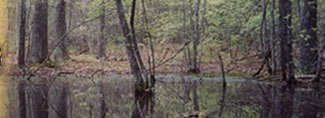• A vernal
pool is a form of temporary, freshwater wetland that contains water
for a portion of the year and supports a fantastic array of wildlife
and plants, some specially adapted for these habitats and many being
rare species in Virginia. Vernal pools are often found in the floodplain
of a stream, in seasonally-flooded woodlands, as sinkhole ponds, or
where rainwater and snow collect in forest depressions.
• Vernal pools
typically dry up in the summer time and fill up with rainwater during
the fall and winter. Drying of the pool prevents fish from being predators
on the pool’s amphibians and other dependent wildlife
• Vernal pool
wetlands are distinguished by the presence of certain indicator species
of wildlife know as “obligates.” The vernal pool obligates
in Virginia are the Spotted Salamander, Marbled Salamander, Wood Frog,
Jefferson Salamander, Mole  Salamander,
Mabee’s Salamander, Tiger Salamander, and several species of Fairy
Shrimp (small, short-lived crustaceans). The breeding presence of any
of these obligates can be used to verify a true vernal pool habitat.
Salamander,
Mabee’s Salamander, Tiger Salamander, and several species of Fairy
Shrimp (small, short-lived crustaceans). The breeding presence of any
of these obligates can be used to verify a true vernal pool habitat.
• Virginia’s
vernal pool obligates include one Endangered Species (Tiger), one Threatened
Species (Mabee’s), and a number of rare, Special Concern animals
(Mole salamander and Fairy Shrimp). Vernal pools also support some of
the state’s rarest wetland plants.
• Vernal pools
have become a rare form of wildlife habitat around the country and especially
in Virginia due to their destruction (being filled in, drained, logged
over, or polluted). They have often been overlooked and considered insignificant
due to their small size as wetlands. Conservation efforts for these
habitats are desperately needed.
• Education
efforts are currently underway to raise awareness for the plight of
vernal pool habitats around the state and to encourage schools, clubs
and individuals to be involved.
• The Vernal
Pool Society of Virginia provides a network for interested parties to
help in the cause for locating (inventory), monitoring (long-term observations),
and preserving these disappearing ponds. Contact the address below for
more information on how your school or group can be involved with vernal
pools.
• The “Schools
for Pools” Program is a pilot project linking students with experts
through live, talk sessions using “Compressed Video Conference”
technology. This allows consultants to guide students and their teachers
in projects to find and study vernal pools in their home areas. Get
involved in your own area of the state. Ask your School’s technology
coordinator about this exciting learning tool.
• Schools
or groups with vernal pools in their communities can adopt these habitats,
monitor their health, and help to conserve one of Virginia’s rare
natural resources.
• Projects
can involve coordinating with the Department of Transportation and local
authorities to assist amphibians in crossing roads that impede their
migrations to vernal pools and result in their mass deaths from encounters
with cars.
• These efforts
can aid state agencies (Department of Game & Inland Fisheries, Division
of Natural Heritage, etc.) in identifying and documenting these rare
natural resources.



![]()




